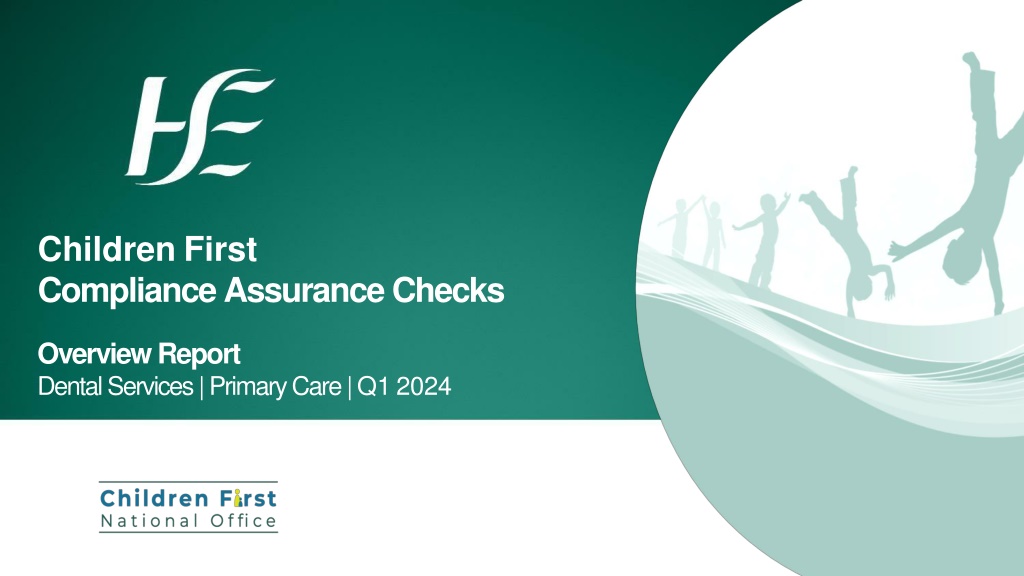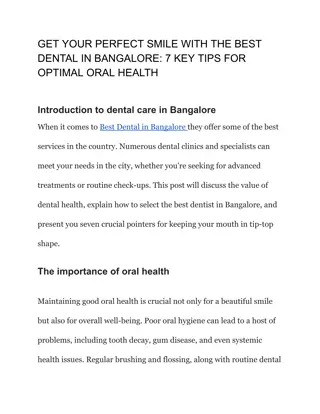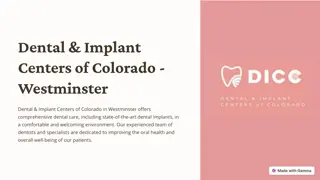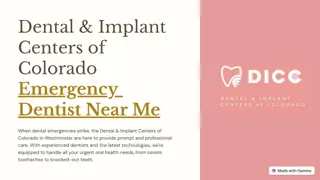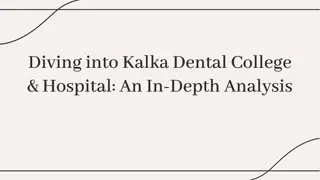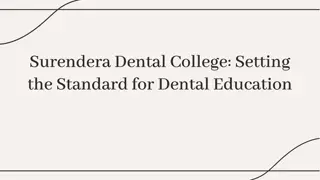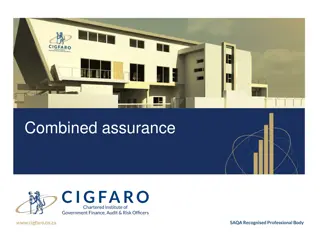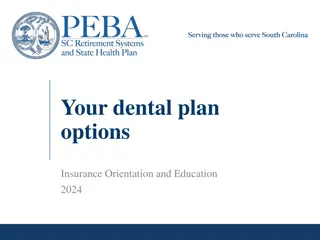Compliance Assurance Report on Dental Services in Q1 2024
A compliance assurance report was conducted on dental services in Q1 2024 as part of the HSE Children First Compliance Assurance Checks. The report highlighted areas of compliance and partial compliance, with efforts noted to meet Children First requirements. Areas of improvement were identified in risk assessments, child safeguarding statements, and management of child protection and welfare records.
Download Presentation

Please find below an Image/Link to download the presentation.
The content on the website is provided AS IS for your information and personal use only. It may not be sold, licensed, or shared on other websites without obtaining consent from the author. Download presentation by click this link. If you encounter any issues during the download, it is possible that the publisher has removed the file from their server.
E N D
Presentation Transcript
Children First Compliance Assurance Checks Overview Report Dental Services | Primary Care |Q12024
Services selected for Compliance Check Dental services were selected to be the focus of HSE Children First Compliance Assurance Checks in Q1 2024. All Dental Service Managers and Heads of Service for Primary Care were invited to attended an Information Session which took place on 8th February 2024 and all were provided with a copy of the HSE Children First Compliance Assurance Framework. Nine HSE Dental Services (one from each CHO) were randomly selected to undergo a Check. Compliance Assurance Checks took place between February and April 2024.
Summary of Findings Areas of Compliance CSS in accordance with legislative requirements CSS in accordance with Tusla guidelines CPW Policy Declaration HSE staff (appendix 3) Sufficient Risk Assessment undertaken CSS Displayed appropriately CSS furnished to all staff CSS reviewed within 24mths Elearning Completed CPW Record Mgt Procedure CPW Reporting Procedures 4 5 0 9 0 0 5 4 0 9 0 0 9 0 0 7 2 0 9 0 0 9 0 0 7 2 0 9 0 0 44% 100% 56% 100% 100% 78% 100% 100% 78% 100% Evidence full compliance Evidence full compliance Evidence full compliance Evidence full compliance Evidence full compliance Evidence full compliance Evidence full compliance Evidence full compliance Evidence full compliance Evidence full compliance *Nine HSE services were selected for Compliance Checks. Evidence of compliance Evidence of partial compliance No evidence of compliance
Summary of Findings (continued) Substantial levels of compliance were noted across the Dental Services selected. It was evident that significant efforts had been made to implement Children First requirements. There were no findings of 'non compliance' noted. Of the 10 requirement areas, six presented evidence of compliance and evidence of partial compliance was found in the remainder. Reasons for findings of partial compliance: 1. There were gaps in some Risk Assessments, and Child Safeguarding Statements were not always developed in line with Guidance issued by Tusla. 2. Some services could not evidence that their Child Safeguarding Statements were reviewed within the legislative timeframe of 24 months. 3. There was confusion about the status of a standard operating procedure, developed by the National Oral Health Office, for the management and storage of Child Protection and Welfare Records, which resulted in appropriate practices not being in place in some services.
Learning | Risk Assessments ANY potential for harm to a child while availing of the service must be considered in a Child Safeguarding Risk Assessment and Child Safeguarding Statements must be developed in line with any guidance issued by Tusla. Tusla consider it "reasonable to expect" that all Relevant Services address specific risks in their Risk Assessments (please see next slide for full details). Two such risks that were not always shown to be considered by dental services are as follows: Risk of harm through access to ICT (e.g. social media or web access, electronic contact, etc. Risk of harm to a child from the use/misuse of digital images/unauthorised photography Note: Services can note N/A in their risk assessments to evidence that they have considered these risks not applicable to their service e.g. risk of harm to a child while on outings is presumably not applicable to Dental Services. In addition to following HSE Guidance on Developing Child Safeguarding Statements it is advisable to refer to the Outcome Review Form used by the Tusla Child Safeguarding Statement Compliance Unit. This form can be found on the Tusla website www.tusla.ie
Learning | 'Guidance issued by Tusla' Tusla consider it "reasonable to expect" that all Relevant Services address the following in their Risk Assessments: 1) Risk of harm* to a child by a member of staff/volunteer (from things they have done e.g. hurt a child, or failed to do e.g. not reporting a concern) 2) Risk of harm to a child caused by a lack of supervision; 3) Risk of to a child by a visitor to the service (contactors, parents, volunteers, etc.); 4) Risk of harm to a child by another child in the service; 5) Risk of harm to a child on outings by a member of staff/volunteer/stranger/peer; 6) Risk of harm through access to ICT (e.g. social media or web access, electronic contact, etc.) 7) Risk of harm to a child from the use/misuse of digital images/unauthorised photography * Harm as defined in the Children First Act 2015. Note: Support for services in considering these risks is provided in the updated HSE Guidance for Developing and Reviewing Child Safeguarding Statements - Risk Assessment Tool (Part B) which is available at www.hse.ie/childrenfirst.
Learning | Record Management Services must have appropriate procedures in place for the management and storage of Child Protection & Welfare records. CP&W records must be stored securely in a manner that upholds the confidential nature of the information; staff members need to be informed about the existence of CP&W records and they should be accessible on a need to know basis. A National Standard Operating Procedure for the management of CP&W in Dental Services was submitted by some services as part of their Checks. While this SOP aligned with the core components of the HSE CP&W Policy, in terms of record management, confusion about the status of the SOP resulted in it not being implemented in some services. The services who were found partially compliant in this area had developed local procedures but they had not been implemented. Services cannot be found compliant if CP&W procedures are not being implemented.
Risk Assessment | Assessment of any potential for harm to a child Overall Findings Children First Act 2015 4 Compliant Requirement 5 Partial Compliance An assessment of any potential for harm to a child must be undertaken (risk assessment). 0 No Evidence of Compliance Key Findings: 44% Compliance Rate Not all services could evidence that they had considered all risks that Tusla consider it reasonable for Relevant Services to address in their Risk Assessments (see Slide 5 for details) One service submitted risk assessments in differing formats. It was recommended that they use the HSE Guidance for Developing and Reviewing a Child Safeguarding Statement to streamline the process.
Child Safeguarding Statement | Legislative Requirements Children First Act 2015 Overall Findings 9 Compliant Requirement 0 Partial Compliance A Child Safeguarding Statement (CSS) must be prepared in accordance with legislative requirements*. 0 No Evidence of Compliance Key Findings: 100% Compliance Rate All Child Safeguarding Statements were deemed to have been developed in line with the requirements of the Children First Act 2015. Note: The procedure for appointing a Relevant Person was not being fully implemented in one service. A review of the procedure was recommended. *(i) The CSS must describe the service being provided and the principles to be observed to safeguard children while availing of the service (ii) A Relevant Person must be appointed for the purpose of the CSS (iii) The CSS must include a written assessment of any potential for harm to a child while availing of the service (iv) The CSS must specify the procedures that are in place to manage any risk identified and the prescribed procedures required to be in place, as listed in Section 11(3) of the Children First Act 2015.
Child Safeguarding Statement | Guidance issued by Tusla Children First Act 2015 Overall Findings 5 Compliant Requirement 4 Partial Compliance A Child Safeguarding Statement must be developed with due regard to, and in accordance with, any guidelines issued by Tusla Child and Family Agency*. 0 No Evidence of Compliance Key Findings: 56% Compliance Rate Some services could not evidence in their risk assessments that they had considered: (i) risk of harm to a child through access to ICT and online activities, and, (ii) risk of harm to a child through the use or misuse of digital images. One service did have a guidance document in place asking that staff inform parents/guardians that dental visits are not to be recorded but this was not mentioned in the Risk Assessment or Child Safeguarding Statement. *Guidelines referenced in this section of report are taken from Tusla's Checklist Review Outcome Form Ref: RF/CSSCU/005
Child Safeguarding Statement | Display Children First Act 2015 Overall Findings 9 Compliant Requirement 0 Partial Compliance A Child Safeguarding Statement must be displayed in a prominent place where the relevant service concerned relates or is provided or both, as may be appropriate. 0 No Evidence of Compliance Key Findings: 100% Compliance Rate Child Safeguarding Statements were displayed appropriately in all sites from which the services operated.
Child Safeguarding Statement | Furnished and made available Children First Act 2015 Overall Findings 9 Compliant Requirement 0 Partial Compliance A provider of a relevant service shall furnish a copy of the Child Safeguarding Statement to members of staff and, on request, to parents, guardians, members of the public and Tusla Child and Family Agency. 0 No Evidence of Compliance 100% Compliance Rate Key Findings: All staff were furnished with a copy of the service's Child Safeguarding Statement and copies were made available to parents, guardians, members of the public and Tusla on request.
Child Safeguarding Statement | Review Children First Act 2015 Overall Findings 7 Compliant Requirement 2 Partial Compliance A provider of a relevant service shall review a Child Safeguarding Statement at intervals of not more than 24 months or as soon as practicable after there has been a material change in any matter to which the statement refers. 0 No Evidence of Compliance 78% Compliance Rate Key Findings: While all Child Safeguarding Statements submitted were in date, one service had reviewed their Statement outside the timeframe of 24 months. One service did not submit a previous Child Safeguarding Statement and could not evidence that their Statements are reviewed every 24 months.
Child Protection & Welfare Policy | Appendix 3 or equivalent Children First Act 2015 Overall Findings 9 Compliant Requirement 0 Partial Compliance All staff must ensure that they have read and understand their responsibilities as set out in the Service's Child Protection and Welfare Policy. 0 No Evidence of Compliance 100% Compliance Rate Key Findings*: Appendix 3 of the HSE CPW Policy was retained by line managers and was signed by all staff. *Please note that findings for this requirement are based on signed declarations of compliance by the Service Managers only.
Mandatory Training | 'An Introduction to Children First' 3 yearly Children First Act 2015 Overall Findings 9 Compliant Requirement 0 Partial Compliance All HSE staff, volunteers, students, contracted staff and staff of HSE funded organisations are required to complete the mandatory HSE eLearning module An Introduction to Children First , as required (currently every 3 years). 0 No Evidence of Compliance 100% Compliance Rate Key Findings*: Mandatory Children First training An Introduction to Children First was up to date for all staff. Certificates of completion are retained on file by line management. *Please note that findings for this requirement are based on signed declarations of compliance by the Service Managers only.
Child Protection & Welfare Records | Procedures for storage Children First Act 2015 Overall Findings 7 Compliant Requirement 2 Partial Compliance Child protection and welfare records must be appropriately filed and securely stored in a manner which upholds the confidential nature of the information. 0 No Evidence of Compliance 78% Compliance Rate Key Findings: While records did appear to be stored securely, record management procedures to ensure appropriate filing and access on a need to know basis were not in place in two services. Note: Both services had identified these gaps in their record keeping practices and in response had developed local procedures; at the time of this Compliance Check they had yet to be implemented.
CP&W Concerns | Reporting Procedure Children First Act 2015 Overall Findings 9 Compliant Requirement 0 Partial Compliance All organisations should have procedures in place for reporting child protection and welfare concerns. Procedures should be made available and followed by all staff members, students and volunteers. 0 No Evidence of Compliance 100% Compliance Rate Key Findings: All services were implementing the HSE Child Protection and Welfare Reporting Procedure.
Please direct queries to: HSE Children First National Office childrenfirst@hse.ie www.hse.ie/childrenfirst
